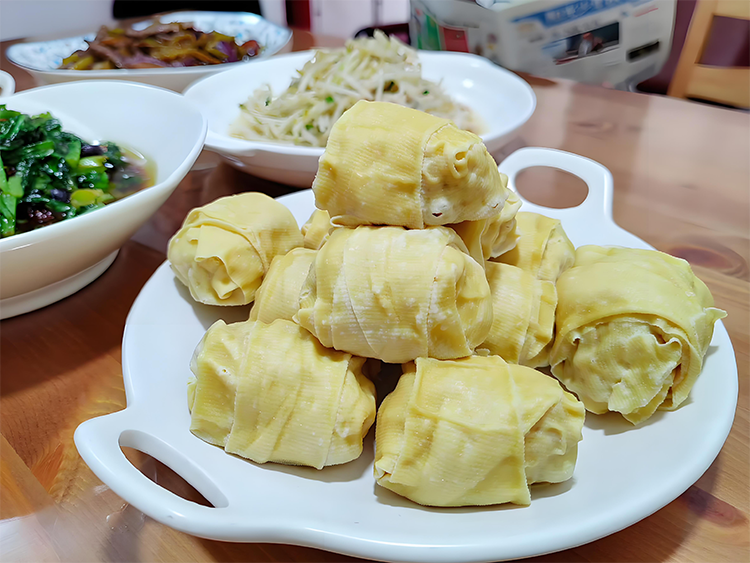Taste Huzhou Qianzhang Bao: Jiangnan Delicacy
Strolling the ancient stones of Huzhou, the steam and aroma from a storefront reveal delicate, pillow-shaped dumplings—Huzhou’s Qianzhang Bao. This century-old tofu-skin specialty is both a culinary delight and a cultural experience you shouldn’t miss when visiting Jiangnan.
1. Century-Old Origin: From Street Vendor to Local Heritage
Huzhou Qianzhang Bao dates back to the Guangxu years of the Qing Dynasty (1878), created by a local vendor named Ding Lianfang. He improved upon popular snacks of the time by inventing a stuffed roll using premium lean pork, dried shrimp (kaiyang), scallops, and tender bamboo skin, all wrapped in the region’s ultra-thin tofu skin called qianzhang. What began as street food quickly became a signature dish and eventually earned provincial intangible cultural heritage recognition.

2. Masterful Filling: A Concentrated Taste of Jiangnan
An authentic Qianzhang Bao centers on meticulously chosen pork from the hind leg—very lean and finely minced. Umami depth comes from dried shrimp and dried scallop, while finely shredded bamboo skin adds a crisp, refreshing note. Toasted sesame finishes the mix, highlighting aromas. These ingredients are balanced with precise seasoning so every bite delivers layered land-and-sea flavors typical of Jiangnan cuisine.

3. Skilled Wrapping: Paper-Thin Tofu Skin Craft
The wrapper is Huzhou’s specialty qianzhang—paper-thin but resilient tofu skin with a gentle bean fragrance. Artisans cut qianzhang into squares, place a generous spoonful of filling, then roll and fold the ends into a neat pillow about ten centimeters long. The craft requires skill to keep the skin intact while achieving the signature “more filling, thinner skin” texture. A thin qianzhang strip is tied around each roll to secure it.

4. Peak Flavor: Savory, Sweet, and Never Greasy
When steamed, the qianzhang becomes slightly chewy with subtle bean aroma. Juices burst from the filling—lean pork richness, the sea-sweetness of dried scallop, the savory bite of dried shrimp, and the crispness of bamboo skin layered with sesame fragrance. Seasoning is restrained and refined, reflecting Zhejiang culinary ideals: fresh, light, and true to the ingredients. The result is flavorful yet not oily.

5. Traditional Serving: The Perfect Pairing with Vermicelli
Locals rarely eat Qianzhang Bao alone. Its classic pairing is a bowl of mung-bean vermicelli (green bean threads). Several Qianzhang Bao simmer together with vermicelli in a clear broth so the dumplings enrich the soup while the vermicelli soaks up the essence. Garnished with scallions, the combination—soup, vermicelli, and bao—creates a three-part tasting experience: sip the broth, taste the soaked vermicelli, then savor the filled bao.

6. Tourist Tips: Where to Find the Most Authentic Flavor
First-time visitors should look for Ding Lianfang’s century-old shop—the origin and most reliable place for authentic Qianzhang Bao. Order the classic “Qianzhang Bao with vermicelli soup” and be cautious of hot steam on arrival. Portions are usually sold per piece; order extra if hungry. Some stalls offer chili sauce or aromatic vinegar for dipping to add another dimension.

7. Homemade Shortcut: Recreating Jiangnan Flavors at Home
You can make a simple home version with ingredients from Asian markets: thin tofu skin (qianzhang), minced pork, dried shrimp, soaked dried scallop (or omitted), shredded bamboo or soaked bamboo shoots, and toasted sesame. Rehydrate and chop the dried ingredients, mix with pork and seasonings, wrap in softened qianzhang into rectangles, and steam 15–20 minutes. Simmer vermicelli in light chicken broth for an easy homemade Qianzhang Bao vermicelli soup.

Summary
Huzhou Qianzhang Bao is more than a snack—it’s edible history and a Jiangnan poem on a plate. From Ding Lianfang’s original innovation to today’s heritage recognition, this tofu-skin dumpling captures delicate, layered flavors and skilled craftsmanship. Add Huzhou to your China itinerary and taste this century-old specialty for a true local experience.


